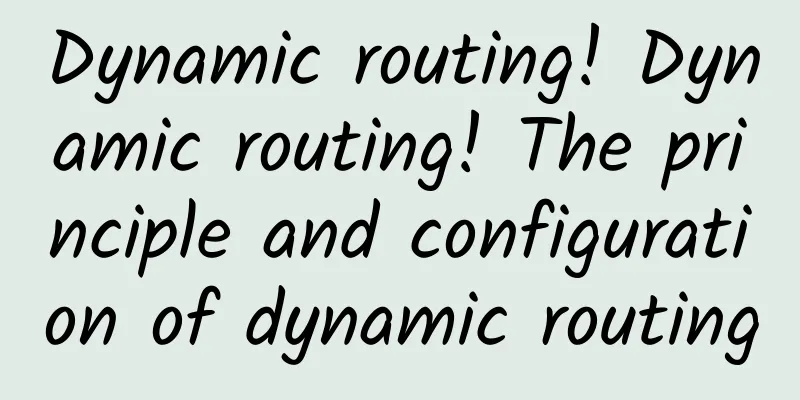Dynamic routing! Dynamic routing! The principle and configuration of dynamic routing

|
1. Introduction to dynamic routing 1. Dynamic routing Refers to the use of routing protocols by routers to learn about networks and update routing tables. 2. Routing protocol classification 3. Introduction to administrative distance Administrative distance (AD) is used to determine the credibility of routing information received from adjacent routers. It is an integer from 0 to 255, where 0 means the highest credibility and 255 means that no data flow will use the corresponding route. Default pipeline distance (Show ip protocols to view the AD value of dynamic routing) 4. Metrics A metric is a value that a routing protocol assigns to the cost of routing a network to a remote network. The metrics used in IP routing protocols are as follows: 5. Convergence
6. Distance Vector-Routing Loops (1) What is a routing loop? A routing loop is a phenomenon in which a data packet is continuously transmitted between a series of routers but never reaches its intended destination network. (2) Impact of routing loops
(3) Anti-loop mechanism
2. Update of RIP routing information 1. RIP routing information updates are based on time period updates (update period is 30 seconds) When the network topology connected to router A changes, router A updates its routing table and waits until the next sending cycle to announce the updated routing table. After receiving this update information, router B updates its own routing table 2. RIP configuration Configuration commands:
network Classified network (network10.0.0.0network tells the routing protocol RIP which classified networks to announce)
View the show ip route command The experimental environment is as follows: (1) Configure the IP address of router R2 interface and configure RIP routing (2) Set up routers R1 and R3 in the same way (3) View the routing table show ip route |
<<: "Feng Qingyang" Jack Ma will "retire" and look back at the 20 years of China's Internet trends
>>: Enterprise Network Data Communication Solution Practice - EIGRP
Recommend
A Brief Analysis of Web3.0 Technology
Part 01 Web3.0 concepts and features Web3.0 is a ...
Synchronized is the king's harem manager, and thread is the queen
If synchronized is the "chief steward" ...
A400 20% off for the school season, Los Angeles CN2 GIA/9929/4837 and other routes starting from 20 yuan/month
A400 Interconnect recently released a back-to-sch...
Using data to speak, Hubo Technology helps improve college students' critical thinking and research capabilities
Recently, in order to enrich product functions an...
Is wireless mesh networking viable for the enterprise?
Wireless mesh networks have gained widespread att...
EtherNetservers: Los Angeles/New Jersey/Miami VPS annual payment starts at $14.95, supports Alipay/PayPal payment
EtherNetservers released the latest promotion in ...
Why migrate to UCaaS? The reasons are many and obvious
[[395094]] Research shows that the future of ente...
WOT Zhang Fuxing: Evolution of Zhihu container platform and its integration with big data
[51CTO.com original article] On May 18-19, 2018, ...
How practical is 5G for ordinary people?
5G has three main advantages over 4G: high speed,...
Six key trends in network management
We live in an era of rapid development of IT tech...
The arrival of the fourth largest operator, what can it change?
On October 12, China Broadcasting Network Co., Lt...
Ruizhi Big Data: Injecting Intelligent Genes into Dual-State IT
In the summer of 2019, a set of data about China&...
What did Chinese operators show the world at the Winter Olympics?
This Winter Olympics is full of technological con...
Huawei Enjoy 10S experience: OLED pearl screen + screen fingerprint unlocking, the benchmark of 1,000 yuan is stable
This afternoon, Huawei held a new product launch ...
Ruijie's "Pioneer Wireless Office" settled in the Fortune 500 Kangmei Pharmaceutical and solved Wi-Fi problems in depth
Today, deploying Wi-Fi has become an important pa...









